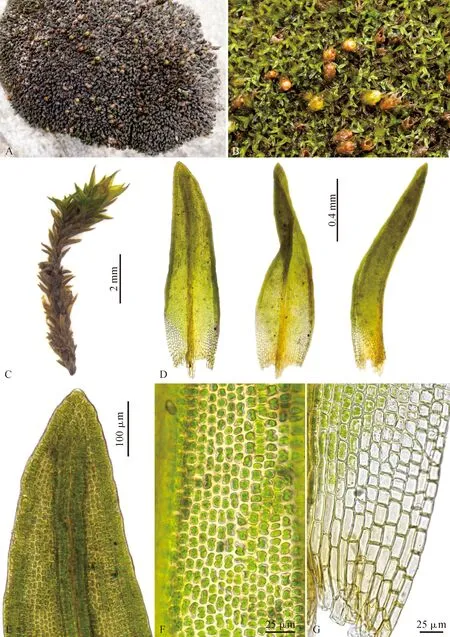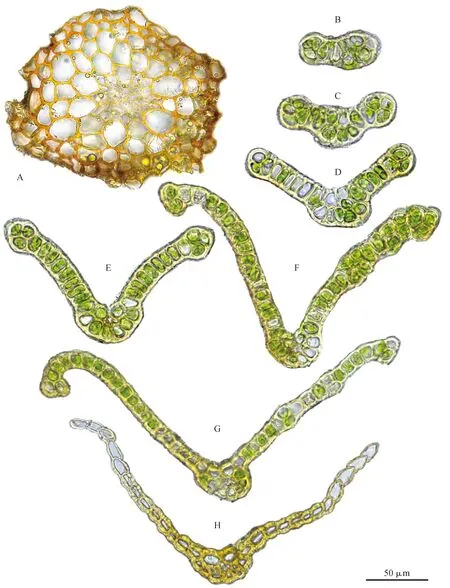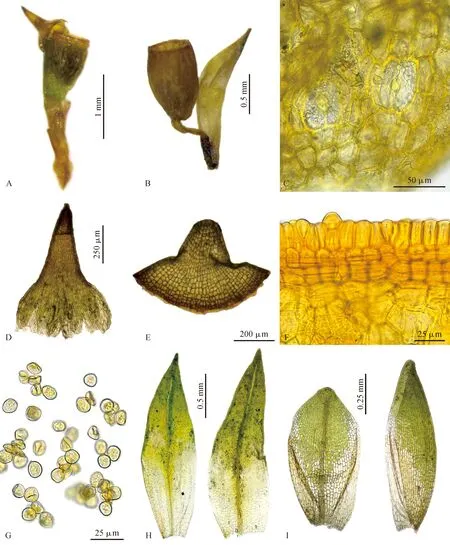紫萼藓科植物一新种
——曹氏紫萼藓
2023-01-04买买提明苏来曼赵东平
买买提明·苏来曼,赵东平,何 思
(1 新疆大学 生命科学与技术学院,乌鲁木齐 830046;2 内蒙古大学 生命科学学院,呼和浩特 010020;3 美国密苏里植物园,圣路易斯 63110)
Alpine glacier area often harbors an unusual habitat for certain kind of plant communities which can grow withstanding an extremely harsh environmental condition. Tomur Mountain, one of the most developed modern Glacier areas in China, is located at the western end of Tianshan Mountains and encompasses about 3 000 km2of rugged ridges and narrow valleys with elevations from 2 000 to 7 000 m. With a typical continental climate, the area is characterized vertically by seven distinctive vegetation zones from temperate desert, low mountain temperate desert and steppe, mountain cold temperate steppe, subalpine cold temperate steppe, alpine grassland, alpine cushion vegetation to alpine tundra[1].
In Tomur Mountain, there is a significant bryophyte flora represented by members of drought resistant families, such as the Grimmiaceae and Pottiaceae, growing on rocks and nourished by thawed snow. Since 2009, nearly 2 500 bryophyte specimens in 79 genera and 246 species have been collected from Tomur Peak National Nature Reserve[2]. In this place, the species ofGrimmiaHedw. are typical members of moss communities, forming an extensive coverage on rock surface. Among the collections we studied, a distinctiveGrimmiaspecimen caught our attention because its leaves are without hair-points and its capsules are immersed, lacking peristome. The plants are dull, greyish green, growing in dense low patches together withGrimmiaanodonBruch & Schimp. The latter species can easily be recognized by its blackish cushions with distinctive hair-pointed leaves. A further study revealed that it is unique for aGrimmiaspecies to have such a combination of characters, i.e. lack of leaf hair-points, a sigmoid seta supporting an immersed and gymnostomous capsule[3-10]. An opinion on this unknown moss was sought from a specialist of the Grimmiaceae, Prof. Cao Tong, who did not consider it was same as any known species ofGrimmia. It is here described as a new species ofGrimmia.
1 Materials and methods
The new species described in this paper was collected by the first author during a field trip to Tomur Peak National Natural Reserve in 2014. The type specimens are deposited at HIMC, MO, SHTU and XJU. The material was studied with the conventional anatomical and morphological methods applied for the taxonomic study of mosses, particularly following those used forGrimmiaby Maier[11]. Microscopic examinations, measurements, and photographs were carried out with a Leica-DM5000 light microscope (LM).
2 Results
GrimmiacaotongianaD.P.Zhao,S.Mamtimin&S.He,sp.nov.(PlateⅠ-Ⅲ)
DiagnosisIt differs from all other species of the genusGrimmiaby autoicous sexuality, obtuse leaf apices without hair points, hyaline basal leaf cells with evenly thick-walled juxtacostal cells and thin-walled marginal cells, an immersed capsule supported by a sigmoid seta, and the absence of peristome.
TypeChina, Xinjiang Uyghur Autonomous Region: Aksu City, Wensu County, Tomur Peak National Nature Reserve, on rock, 41°51′19.21″N, 80°40′00.67″E, 2 446 m, 27 August 2014,S.Mamtimin24670 (holotype: XJU!; isotypes: HIMC!, MO!, SHTU!).
DescriptionPlants small in dull, dense low patches, greyish green above, yellowish brown below. Stems 0.7-1.0 cm high, erect, usually irregularly branched, transverse section rounded, without hyalodermis, sclerodermis weakly differentiated, a central strand well-developed. Leaves appressed when dry, spreading when moist, broadly ovate-lanceolate, 1.26-1.61×0.28-0.45 mm, obtuse at apex, hair points absent, widely keeled above, without a distinct shoulder, not plicate, shortly decurrent; margins narrowly recurved in middle part of leaf on one side, rarely recurved on both sides, plane distally and proximally, bistratose to irregularly bistratose from apex to widest part of leaf margin, unistratose at leaf base; central leaf lamina smooth, unistratose nearly throughout, rarely few bistratose cell rows in various places, upper and median laminal cells incrassate, irregularly rounded quadrate to short-rectangular, 5.3-14.2×5.3-10.6 μm, thick-walled, slightly sinuose; transitional and lower laminal cells slightly elongate, moderately thick-walled, nearly straight to somewhat sinuose; basal marginal cells rectangular, 15.4-26.4×10.5-12.9 μm, hyaline, transverse walls thicker than the longitudinal walls, vertical walls straight, hyaline cells vanishing in broadest part of leaf; basal juxtacostal cells elongate-rectangular, 24.3-49.1 × 7.9-9.4 mm, mostly hyaline, equally thick-walled, slightly nodulose. Costa subpercurrent, clearly vanishing below apex, gradually narrowed towards leaf base, projecting on abaxial side, channelled on adaxial side, with two adaxial surface cells throughout, in the upper and middle part 48.21-56.77 μm wide, with 2-6 abaxial surface cells, in the lower part 43.97-49.83 μm wide, with 5-6 abaxial surface cells. Propagula absent.
Autoicous. Perichaetial leaves 2.1-2.7×5.8-8.3 mm, considerably longer and broader than stem leaves, acute at apex, hair points absent, sheathing and hyaline in lower part, narrowed and concave at base; margin plane to slightly recurved; costa vanishing below apex. Perigonia on short stalks, located on subperichaetial branches, innermost perigonial leaves, ovate, 0.8-1.0×0.5-0.6 mm, obtuse at apex, hair points absent, sheathing, hyaline at base, the hyaline cells disappearing at some marginal rows in upper part, costa ending below apex; margin plane. Seta sigmoid, 0.3-0.5 mm long. Capsule immersed, ventricose, obovoid, ribbed; exothecial cells irregular quadrate, rectangular or in variable shapes, thin-walled; stomata present at the base; annulus consisting of 2-3 rows of differentiated cells. Calyptra mitrate, lobed, covering operculum. Operculum short-conical, with an obtuse beak. Peristome none. Spores subspherical, 10-12 μm in diameter, smooth.
EtymologyThe species epithet is to honor Prof. Cao Tong, a bryologist at Shanghai Normal University, in appreciation for his important contributions to our knowledge of the Grimmiaceae.
HabitatanddistributionGrimmiacaotongianais currently known only from the type locality. It was collected from limestone rock on the grass land in coniferous forests (Plate Ⅳ), dominated byPiceaschrenkianaFisch. & C.A. Mey. on the southern slope of Tomur Mountain where an annual rainfall is averaged less than 300 mm[12]. It was found in association withGrimmiaanodon. The new species may be discovered in the future at other similar habitats in the region.
3 Discussion
Grimmiacaotongianabelongs to the subg.GasterogrimmiaSchimp. for having immersed, ventricose capsules on arcuate or sigmoid setae that are eccentrically attached. Most members of this subgenus are restricted to calcareous habitats[9]. The new species is very similar toG.anodonin having immersed, ventricose capsules on very short and sigmoid setae, no peristome (Plate Ⅲ,Fig. A, Fig.B), large stomata at the very base of the capsule walls (Plate Ⅲ,Fig. C), unistratose central lamina, and bistratose margins (Plate Ⅱ,Fig. B-Fig. G). It differs fromG.anodonby the absence of hair points in both vegetative and perichaetial leaves (Plate Ⅰ,Fig.A-Fig.E, Plate Ⅲ, Fig.H), the leaf margins narrowly recurved at middle and lower parts (Plate Ⅱ,Fig. F& Fig. G), and basal juxtacostal cells mostly hyaline, with walls distinctly thicker than those of basal marginal cells (Plate Ⅰ,Fig.G, Plate Ⅱ,Fig.H). In contrast,Grimmiaanodonhas plane leaf margins, short to long hair points in vegetative and perichaetial leave, and basal juxtacostal cells mostly greenish with wall thickening the same as basal marginal cells. Another widespread species,G.plagiopodiaHedw. in the same subgenus can be distinguished fromG.caotongianaby having peristome teeth and unitratose lamina throughout.

Plate Ⅰ Grimmia caotongiana D.P.Zhao, S.Mamtimin & S.HeFig. A. Habit (dry); Fig. B. Habit (wet); Fig. C. Plant when moist; Fig. D. Leaves; Fig. E. Leaf apex; Fig. F. Median leaf cells; Fig. G. Basal leaf cells; All prepared from S. Mamtimin 24670 (Holotype, XJU)

Plate Ⅱ Grimmia caotongiana D.P.Zhao, S.Mamtimin & S.HeFig.A. Stem transverse section; Fig.B-Fig.H. Transverse sections of a leaf from upper to basal parts. All prepared from S. Mamtimin 24670 (Holotype, XJU)

Plate Ⅲ Grimmia caotongiana D.P.Zhao, S.Mamtimin & S.HeFig.A and Fig. B. Capsules; Fig.C. Stomata; Fig.D. Calyptra; Fig.E. Operculum; Fig.F. Exothecial cells and annulus; Fig.G. Spores; Fig.H. Perichaetial leaves; Fig.I. Perigonial leaves. All prepared from S. Mamtimin 24670 (Holotype, XJU)
G.caotongianamay also be confused with someGrimmiaspecies with muticous leaf apices, such asG.atrataMiel. ex Hornsch.,G.handeliiBroth., andG.ochyrianaJ. Muoz. However,G.atrataandG.handeliidiffer fromG.caotongianain their long exserted capsules on straight setae. AlthoughG.ochyriana, an endemic species in the Himalayas, has similar immersed capsules on arcuate setae when dry, it differs fromG.caotongianaby bistratose lamina in the distal half and the presence of peristome. In addition, two otherGrimmiaspecies in China,G.crassiusculaGreven & C. Feng andG.unicolorHook., are somewhat similar toG.caotongianain having muticous leaf apices. However, the latter two species have succulent leaves, cucullate leaf apices, completely bistratose lamina in the medial and distal parts, and a costa that is not projecting on dorsal side. With the description of this new species, there are now 26 species ofGrimmiareported from Xinjiang[10].
Acknowledgements:We thank the Tomur Peak National Nature Reserve for the permission to collect bryophytes.
KeytosimilarspeciesofGrimmiacaotongiana
1. Leaves awned or muticous; seta eccentrically attached to capsule base; capsule immersed, smooth, ventricose; stomata 3-4, large, at base of capsule
2
1. Leaves muticous; seta centrally attached to capsule base; capsule immersed to exserted, smooth to plicate, not ventricose; stomata none to many, small, at neck to base of capsule
4
2. Peristome present, annulus absent; distal lamina 1-stratose, margins 1-or 2-stratose
G.plagiopodia
2. Peristome absent, annulus present; distal lamina 1-stratose with 2-stratose patches, margins 2-stratose
3
3. Vegetative and perichaetial leaves awned
G.anodon
3. Vegetative and perichaetial leaves muticous
G.caotongiana
4. Leaves merely 1-stratose distally
5
4. Leaves merely 2-3 stratose distally
6
5. Plant interwoven with young and radiculose shoots
G.handelii
5. Plant without young and radiculose shoots
G.atrata
6. Leaves apex not cucullate, margins recurved
G.ochyriana
6. Leaves apex cucullate, margins plane
7
7. Central strand present; leaves sheathing with prominent shoulders
G.unicolor
7. Central strand absent; leaves not sheathing, without shoulders
G.crassiuscula
